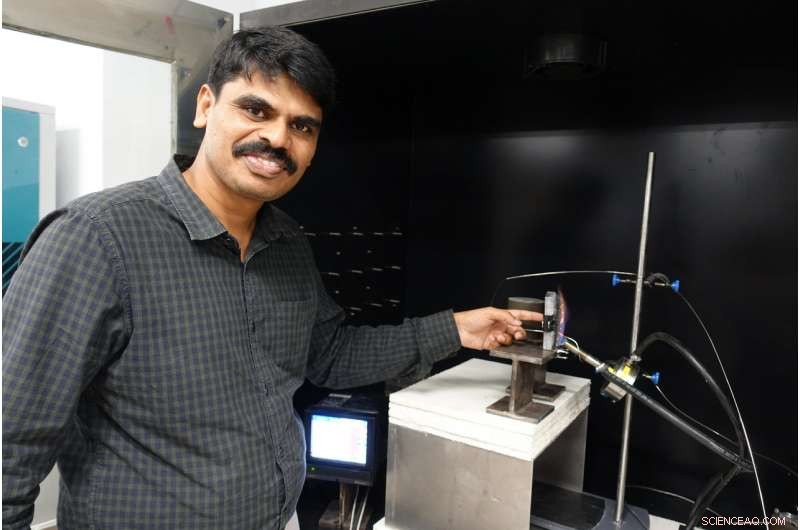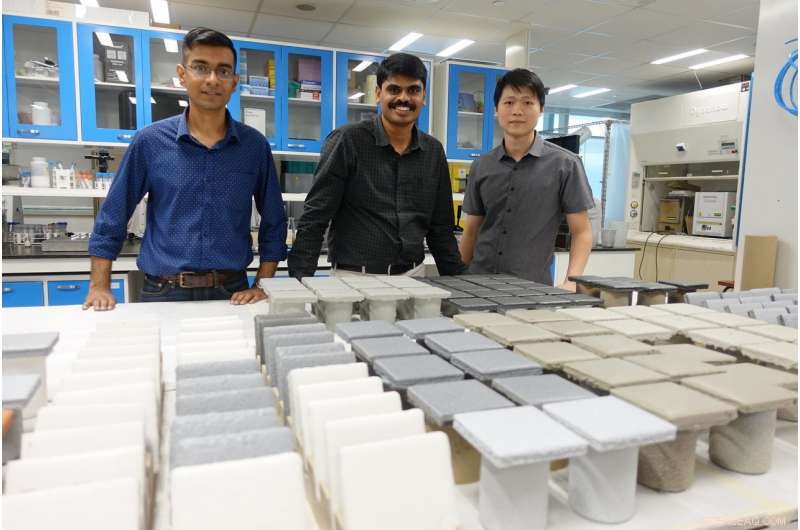
NTU biträdande professor Aravind Dasari sätter fingret på en plastbit som är sval nog att röra vid, som placerades bakom en stålplåt belagd med FiroShield och utsattes för en låga över 900 grader Celsius. Kredit:Nanyang Technological University
Ett par extra lager "färg" kan vara allt som stålet i en byggnad behöver för att förhindra att det buktar sig och går sönder i en brand.
Forskare från Nanyang Technological University, Singapore (NTU Singapore) och Singapores industriutvecklare JTC har utvecklat en prisvärd 3-i-1-beläggning som ger förbättrat brand- och korrosionsskydd.
Befintliga stålkonstruktioner i byggnader är vanligtvis belagda med ett brandskyddande skikt för att skydda den blotta metallen från brandskador och uppfylla brandskyddsstandarden på två timmar – i syfte att ge de boende tillräckligt med tid att evakuera byggnaden. Dagens konventionella svällande beläggningar är tjocka, dyrare och jobbigare att applicera.
I kontrast, denna tillverkade i Singapore beläggning kan appliceras på rent stål utan att behöva sandblästra för att förbereda ytan, minska beläggningstiden med hälften, och kommer att skydda materialet mot brand i två timmar utan att falla av.
heter FiroShield, den nya beläggningen är billigare och mindre mödosam att applicera, och kan fungera estetiskt som vanlig färg.
FiroShield har även testats på andra byggmaterial, såsom armerad betong och laminerat virke, och har samma utmärkta prestanda.
Leder forskargruppen är biträdande professor Aravind Dasari från School of Materials Science and Engineering och professor Tan Kang Hai från School of Civil and Environmental Engineering.
Teamledarna sa att kunskapen som de har fått under årens forskning om olika aspekter av polymerer och förbränning, kombinerat med byggnads- och byggnadsteknisk erfarenhet, hjälpte till att effektivisera deras tillvägagångssätt.
Styrkan i deras beläggning kommer från en balanserad blandning av tillsatser, som fungerar bra tillsammans för att avge samtidiga kemiska reaktioner när de står inför extremt höga temperaturer. De visste att de hade hittat rätt formel när de kunde belägga stålprover jämnt med en sprutpistol.
"I en eld, vår beläggning bildar ett kompakt förkolnat lager som fungerar som en skyddande barriär mot värmen, " tillade prof Dasari, som också är huvudutredare vid NTU-JTC Industrial Infrastructure Innovation Centre (I3 Centre).
"Medan typiska brandbeläggningar också kommer att bilda ett förkolnat lager, de är tjocka och skumliknande, som lätt kan falla av och lämna stålet utsatt för elden. Det vi siktade på var en innovativ beläggning som fungerar annorlunda än konventionella svällande beläggningar och som kan fästa på stålytan så länge som möjligt under höga temperaturer, och har ändå hållbarhet och väderbeständighet under normala förhållanden utan att behöva ett topplack. "
Herr Koh Chwee, Direktör, Technical Services Division av JTC och meddirektör för I3 Centre, sa att genom samarbete med akademiska institutioner som NTU, JTC siktar på att utveckla nya och innovativa lösningar för att öka säkerheten och byggproduktiviteten för sina industriella infrastrukturprojekt.
"Lättheten att applicera denna nya brand- och korrosionsbeständiga beläggning på stålkonstruktioner kommer att bidra till att minska arbetsintensivt arbete, vilket förbättrar produktiviteten och möjliggör snabbare beläggning av prefabricerade stålkomponenter. Mer viktigt, den nya beläggningens förmåga att bibehålla överlägsen vidhäftning under höga temperaturer leder till ökad byggsäkerhet för passagerarna. Vi är övertygade om att den nya beläggningen kommer att kunna minska både färgmaterial och arbetskostnader, och bli ett nytt alternativ till andra brandskyddsprodukter, " said Mr Koh.
Combination of materials used for coating
The base material of the new coating is made of synthetic resins, which are polymers commonly used to make paints. To give it fire and corrosion-resistant properties, Prof Dasari's team added a combination of common chemicals, including one that is endothermic – absorbing heat to start a chemical reaction that causes the coating to adhere firmly to the steel.
The team went further to develop a coating that is able to have assorted colours; pigments can be added to the mixture so it achieves the aesthetic function of normal paint. Paint manufacturers looking to add the benefits of FiroShield to their products should find that commercialisation is straightforward, as the innovation relies simply on the addition of key chemicals into their paint manufacturing process.

(From left) NTU research fellow Dr Indraneel S Zope; NTU Assistant Professor Aravind Dasari; and NTU PhD student Mr Ng Yan Hao; standing behind the rows of FiroShield-coated steel plates used in their research and development.
To achieve a two-hour fire rating, FiroShield requires just five layers of coating, compared to conventional coatings, which requires up to 15 layers or more. It is thus two times faster to apply and is cheaper by about 50 percent due to its lower materials cost and manpower requirements.
In addition to its fire-resistant properties and easy application, FiroShield can also protect the steel surface from corrosion, which no other fire coatings in the market can do at the moment. FiroShield is expected to last longer when exposed to weathering elements such as moisture and UV rays. Its performance barely dipped by two percent, as compared to the drop of up to 75 percent for conventional coatings when subjected to weathering tests in the lab. This will reduce the maintenance cost and frequency of inspections over the lifespan of a building.
For the next phase of development, FiroShield will be sent to the UK for an industry certification, which includes a load-bearing fire test that no facilities in Singapore can do currently.
Its proprietary formulation has been filed with NTU's innovation and enterprise arm, NTUitive, and upon the completion of the certification, NTUitive will work with JTC to explore commercialisation options.
After the certification, which is expected to be completed by April 2018, the new coating will be applied on steel structures within the upcoming JTC Logistics Hub. The joint research team will also work with the relevant agencies to roll out this technology on a larger scale.
Building on this technology, Asst Prof Dasari will also work with JTC at the I3 Centre to develop another type of innovative coating for the construction and building industry, which addresses more properties beyond fire and corrosion resistance.